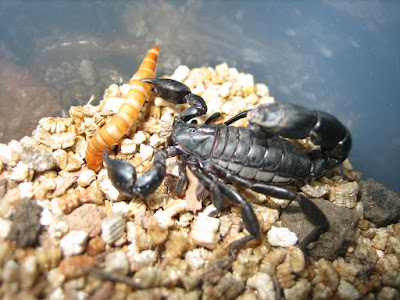Mountain cowslip Primula auricula, copyright Octopus.
Belongs within: Primulales.
Primula, the primroses, is a group of perennial herbs and subshrubs found primarily in northern temperate regions (Hickman 1993).
Characters (from Hickman 1993): Perennial, rhizomed, sometimes stoloned. Leaves basal or crowded on branches near ground, sessile. Inflorescence an umbel, one per scapose peduncle, terminal, subtended by bracts. Flower parts in fives; calyx tube angled; corolla funnel-shaped or salverform, lobes spreading or erect, entire or notched at tip; stamens included, filaments short, anthers oblong, obtuse; ovary superior. Fruit five-valved, elliptic to ovate. Seeds many, peltate, dotted.
<==Primula
`--P. subg. Auriculastrum sect. Auricula PS98
| i. s.: P. × pubescens [P. auricula × P. hirsuta] PS98
| P. recubariensis Prosser & Scortegagna 1998 PS98
| P. × vallarsae Prosser & Scortegagna 1998 [P. auricula ssp. ciliata × P. recubariensis] PS98
|--P. (subsect. Arthritica) spectabilis PS98
|--P. subsect. Brevibracteatae PS98
| |--P. albenensis PS98
| |--P. carniolica PS98
| |--P. latifolia PS98
| `--P. marginata PS98
|--P. subsect. Erythrodorsum PS98
| |--P. apennina PS98
| |--P. daonensis PS98
| | |--P. d. var. daonensis PS98
| | `--P. d. var. judicariae Widmer 1891 PS98
| |--P. hirsuta PS98
| |--P. pedemontana PS98
| `--P. villosa PS98
|--P. (subsect. Euauricula) auricula PS98
| |--P. a. ssp. auricula PS98
| `--P. a. ssp. ciliata PS98
`--P. (subsect. Rhopsidium) tyrolensis PS98
Primula incertae sedis:
P. atrodentata O88
P. aureata O88
|--P. a. ssp. aureata O88
`--P. a. ssp. fimbriata O88
P. bellidifolia O88
P. buryana O88
|--P. b. var. buryana O88
`--P. b. var. purpurea O88
P. calderiana O88
|--P. c. ssp. calderiana O88
`--P. c. ssp. strumosa O88
P. capitata O88
|--P. c. ssp. capitata O88
`--P. c. ssp. crispata O88
P. caveana O88
P. concinna O88
P. cortusoides C55
P. denticulata O88
P. deuteronana O88
P. dickieana O88
P. didyma O88
P. edgeworthii O88
P. elatior D51
P. farinosa T30 [incl. P. decipiens C55, P. scotica T30]
P. floribunda D51
P. gambeliana O88
P. geraniifolia O88
P. glabra O88
P. glandulifera O88
P. glomerata O88
P. gracilipes O88
P. hookeri O88
P. involucrata O88
P. japonica JK80
P. juliae MH98
P. kewensis D51
P. macrophylla O88
|--P. m. var. macrophylla O88
`--P. m. var. moorcroftiana O88
P. megalocarpa O88
P. minutissima O88
P. mistassinica A16
P. muscoides O88
P. obliqua O88
P. poluninii O88
P. primulina O88
P. prolifera H03
P. pulchra O88
P. ramzanae O88
P. reidii O88
|--P. r. var. reidii O88
`--P. r. var. williamsii O88
P. reptans O88
P. reticulata O88
P. rotundifolia O88
P. sapphirina O88
P. sharmae O88
P. sieboldii KIW98
P. sikkimensis O88
P. sinensis D37
P. soldanelloides O88
P. spathulifolia O88
P. stirtoniana O88
P. stricta T30
P. stuartii O88
P. suffrutescens H93
P. tanneri O88
|--P. t. ssp. tanneri O88
`--P. t. ssp. nepalensis O88
P. tenuiloba O88
P. tibetica O88
P. uniflora O88
P. veitchiana NDA05
P. veris PT01
P. verticillata D51
P. vulgaris D51
P. walshii O88
P. wigramiana O88
P. wollastonii O88
P. wulfeniana H09
|--P. w. ssp. wulfeniana H09
`--P. w. ssp. baumgarteniana H09
*Type species of generic name indicated
REFERENCES
[A16] Alexander, C. P. 1916. New or little-known crane-flies from the United States and Canada: Tipulidae, Diptera, Part 2.
Proceedings of the Academy of Natural Sciences of Philadelphia 67 (3): 458–514, pls 16–21.
[C55] Candolle, A. de. 1855.
Géographie Botanique Raisonée: Ou exposition des faits principaux et des lois concernant la distribution géographique des plantes de l’époque actuelle vol. 1. Librairie de Victor Masson: Paris.
[D37] Dobzhansky, T. 1937.
Genetics and the Origin of Species. Columbia University Press: New York.
[D51] Dobzhansky, T. 1951.
Genetics and the Origin of Species 3
rd ed. Columbia University Press: New York.
[H03] Heads, M. 2003. Ericaceae in Malesia: vicariance biogeography, terrane tectonics and ecology.
Telopea 10 (1): 311–449.
[H09] Heltmann, H. 2009. Der Königstein (Piatra Craiului), die Perle der Burzenländer Gebirge.
Mauritiana 20 (3): 515–527.
[H93] Hickman, J. C. (ed.) 1993.
The Jepson Manual: Higher Plants of California. University of California Press: Berkeley (California).
[JK80] John, J., & K.-P. Kolbe. 1980. The systematic position of the “Theales” from the viewpoint of serology.
Biochemical Systematics and Ecology 8: 241–248.
[KIW98] Kearns, C. A., D. W. Inouye & N. M. Waser. 1998. Endangered mutualisms: the conservation of plant-pollinator interactions.
Annual Review of Ecology and Systematics 29: 83–112.
[MH98] Morikawa, H., A. Higaki, M. Nohno, M. Takahashi, M. Kamada, M. Nakata, G. Toyohara, Y. Okamura, K. Matsui, S. Kitani, K. Fujita, K. Irifune & N. Goshima. 1998. More than a 600-fold variation in nitrogen dioxide assimilation among 217 plant taxa.
Plant, Cell and Environment 21: 180–190.
[NDA05] Nickrent, D. L., J. P. Der & F. E. Anderson. 2005. Discovery of the photosynthetic relatives of the "Maltese mushroom"
Cynomorium.
BMC Evolutionary Biology 5: 38.
[O88] Ohba, H. 1988. The alpine flora of the Nepal Himalayas: an introductory note.
In: Ohba, H., & S. B. Malla (eds)
The Himalayan Plants vol. 1.
The University Museum, University of Tokyo, Bulletin 31: 19–46.
[PT01] Pemberton, L. M. S., S.-L. Tsai, P. H. Lovell & P. J. Harris. 2001. Epidermal patterning in seedling roots of eudicotyledons.
Annals of Botany 87: 649–654.
[PS98] Prosser, F., & S. Scortegagna. 1998.
Primula recubariensis, a new species of
Primula sect.
Auricula Duby endemic to the SE Prealps, Italy.
Willdenowia 28: 27–46.
[T30] Taylor, G. 1930. Scottish plants growing in their native habitats.
Proceedings of the Linnean Society of London 141: 30–31.










